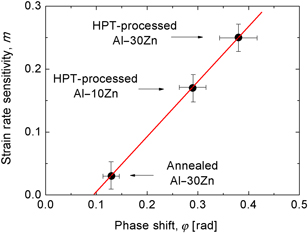Published online by Cambridge University Press: 18 December 2018

The relationship between the oscillatory force and the depth-response during dynamic indentation was analyzed mathematically and investigated experimentally in ultrafine-grained Al–Zn alloys processed by high-pressure torsion. We have shown for the first time that the phase shift between the local oscillatory force and depth signal, caused by the internal friction, is correlated to the strain-rate sensitivity, which is a key parameter indicating the ductility of materials. This correlation enables a new application of dynamic nanoindentation for studying the rate-dependent deformation-mechanisms of materials from a novel aspect.